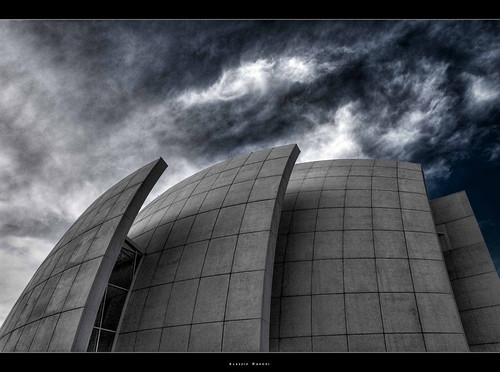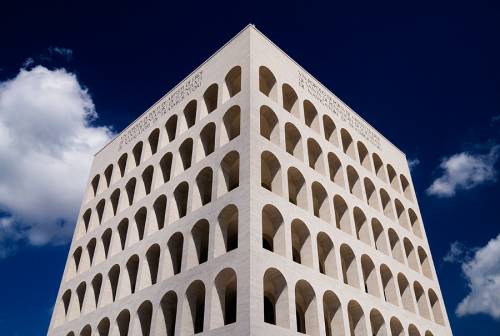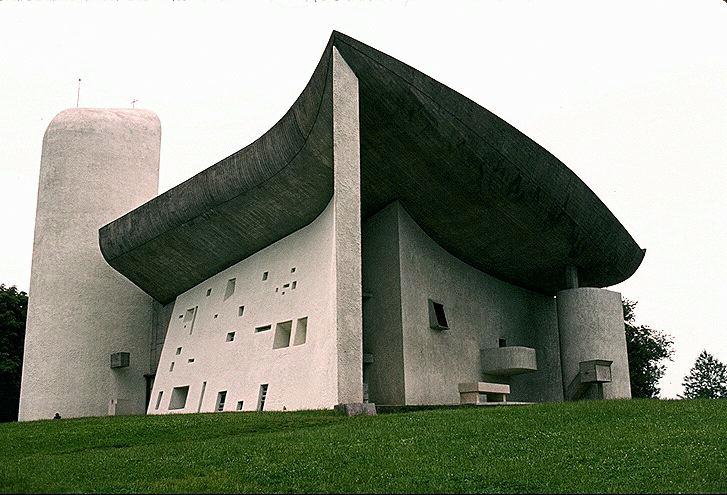il famoso bosco verticale di Tito Boeri a Milano, un grattacielo con una sorta di foresta pensile sui balconi, sta guadagnando sempre più riconoscimenti. Tuttavia per quanto venga presentato come uno strumento di lotta alla crisi climatica mi sembra che si tratti di una ricerca soprattutto estetica, come è tipico in fondo dell'architettura, e che l'ecologia non c'entri nulla. Il bosco verticale èdi grandei impatto visivo, ma richiede enormi quantità di acqua ed energia per mantenersi e credo che se si facesse il calcolo della CO2 tenendo conto di questi costi rappresenti complessivamente un source e non un sink (come accade in gran parte dell'agricoltura industriale).
Visualizzazione post con etichetta architettura. Mostra tutti i post
Visualizzazione post con etichetta architettura. Mostra tutti i post
sabato 3 giugno 2023
martedì 14 luglio 2020
hagia Sofia
Santa Sofia è un sublime, sommo capolavoro dell'architettura mondiale. Quello che però raramente si osserva è che i quattro minareti - costruiti dopo la conquista di Costantinopoli da parte degli ottomani - si fondono perfettamente con la struttura bizantina. Più noto è invece che molte moschee del mondo islamico sono ispirate proprio all'architettura di Santa Sofia, come per esempio la stessa moschea azzurra che gli sta dirimpetto.
domenica 8 settembre 2019
Wroclaw (per un mio giovane amico)
Stavo a Wroclaw per un congresso e mi annoiavo. Preno tre amici e vado a vedere il Centennial Hall, uno dei capisaldi del primo razionalismo: fulminante, Vedere il vero razionalismo ti fa capire il gigantesco bliff che è stato la tanto esaltata architettura fascista (esaltata solo qui perché fguori dal Bel Paese non la conosce nessuno).
venerdì 24 agosto 2018
Collapsing bridges, crumblingconcrete
The episode of the collapse of the bridge in Genoa has a deeper meaning than the rapacity of Italian capitalists and poor state of infrastucture in Italy. There was a time when there was an aesthetic of concrete ("béton brut") whihc represented progress and the beauty of modernity. And now we realize that reinforced concrete after only a few decades is crumbling, and that our civilistationsrisks to leave nothing of its architectonical endeavours in striking contrast with the eternity of the pyramids and the Roman aqueducts. It is a sad morale that the objects of the mdoernsit revolution are crumpling and perishable. It seems nonetheless that if concrete is added with some types of organic material it becomes super strong - maybe ecology is treally the answer to the crise of modernity.
Etichette:
architettura,
ecology,
modernità,
razionalismo
martedì 8 settembre 2015
From Bauhaus to modern house
I am reading Tom Wolfe's "from Bauhaus to our house", which describes the rise of modern archtiecture, in particular in the Uniited Staes. In the first chapter he describes the adventure of Bauhaus, whith his aim of starting again from zero. A funny book, very well written, but I'am afraid that it misses entirely the point. The poitn was not Bauhaus against Art Nouveau, but Bauhaus agaisnt the eclectism and the neogothic. Art Nouveau was and avant-garde, but the style of XIX century was for instance that of the rail station of Milan, which is a false. The revolt was not against bourgeoisie (although after the Russian Revolution a reference to socialism was obvious), but against hypochrysy, and the pure forms of modern architecture were a revolt against untruth.
sabato 21 dicembre 2013
Bauhaus
I mobili IKEA sono la realizzazione su larghissima scala del sogno degli arts and crafts e del Bauhaus, ma che realizzazione triste!
giovedì 2 maggio 2013
Fascism and rationalism
Fascist architecture and rationalist architecture look alike - they developed after all more or less in the same years. Anyway this resemblance is very superficial. In fact the architecture of Le Corbuser, Gropius, Mies van der Rohe is rational not or not only because it employs simple shapes with no decoration - parallelepipeds, cubes - but above all because it is functional - buildings should be "machines for living".
But fascists building are all but machines for living. They must impress and terrify, not be friendly. Huge staircaases, disproportionate volumes, a tendence to be higher than large. The style is the same - blocks, rows of frameless windows - but the meaning is opposite.
But fascists building are all but machines for living. They must impress and terrify, not be friendly. Huge staircaases, disproportionate volumes, a tendence to be higher than large. The style is the same - blocks, rows of frameless windows - but the meaning is opposite.
Of course, this doesn't mean that a few examples fo this architecture can be aesthetically pleasnt - for instance the "Palazzo della civiltà del lavoro" that is discussed in another post (http://castorphans.blogspot.it/2011/03/colosseo-quadrato.html) or the astounding "Casa del Fascio" in Como.
Etichette:
architettura,
fascismo,
Le Corbusier
sabato 23 luglio 2011
Drawing

Architecture still relies on the Reinessance idea that if you can draw, you can create the world - buildings, paintings, machines, a few century after industrial objects - and thus you are like god. The free masons symbolism of square and compass and the famous painting of the creation where god is represented as an architect is based on this idea. A corollary to the idea is that the architect - not the painter nor the sculptor, that create only images of the world - is like god. The idea is still among us: if you are acquainted with architects you certainly had the feeling that they believe to be able to do everything - to be omni-potent. But science, that rised at the end of the Reinessance - has told us that the structure of the world - and therefore the ability to modify it or even create things - is based on certain mathematical relationships among the parts - in some way Pythagorean conceptions are at the base of our modern vision of the world, and it is no case that Kepler was guided by Pythagorean principles in the discovery of the laws of motion of planets. Drawing as nothing to do with these mathematical relationships, although it can suggest them, and this explains why archtitect believe they can do everything but usually are able to do nothing - often not even buildings.
Etichette:
architettura,
dio,
Keplero,
Pitagora,
Rinascimento,
scienza
venerdì 22 luglio 2011
Meier

I recentrly visited the "Jubilaeum church" of Richard Meier in Tor Tre Teste, in the suburbs of Rome. Simply perfect, and the comparison of this church with the "Ara pacis", that is not a very successful building, imposes a couple of consideration. The first is that the commisioner of a building does matter: the Church has a little more experience than Walter Veltroni in art and architecture. The second is that the leftist government of Rome of the former years wanted to break drastically with the past in inserting a modernist intervention in the fundamentally baroque urban tissue of the centre of Rome - but at the same time asked Meier not to break too drastically with the case that dated to the '30s of the last century and was a modest example of fascist rationalism -so that the german architect was obliged to reconcile his "lecorbuserian" conception with the fascist pompous attitude, he had to mantain more or less the original proportion and the organization of the ceiling, he had to build a wall of travertine - travertine was much loved by fascists because it reminded the Colosseum, but originally travertine was a relatively poor material that was hidden - in the Colosseum and elseqhere, by wonderfully coloured marbles .... In practice, the usualo stop and go strategy of PCI-PDS-PD
Etichette:
Ara Pacis,
architettura,
Chiesa,
Colosseo,
committente,
Meier,
PD,
razionalismo,
Roma,
travertino,
Veltroni
sabato 5 marzo 2011
Colosseo Quadrato

The "Colosseo Quadrato" (Palce of the Italian Civilization) of EUR in Rome is a striking monument. I had occasion to observe it closely for a long period. It changes poetically its colour with weather conditions and the large glasses of the windows reflect the clouds of the sky. The strong shadows of the "holes" change ceaselessly with the time of the day. In summary, apart its obvious metaphysic character, it interacts with the surrounding environment in a fascinating way. The only problem is, that its volumes are useless for living, work, exposition, any other practical use. In other words, it is not architecture, but an (oversized) installation. Considering that perhaps the first recognized installations are by Fontana fifteen years later, quite an interesting piece of art.
Etichette:
architettura,
fascismo,
razionalismo
giovedì 20 gennaio 2011
Fascist architecture
Although most architects coming from the school of the University of Rome are thrown into ecstasis when considering italian architecture of the fascist period, in particular the important examples of Rome, I personally believe this architecture to be rather horrible. Of course, the fascist regime contracted only excellent architects, the rationalism of Libera and Michelucci was very "modern" with respect to the current architecture of the time, but buildings such as the Palazzo delle Poste in via Marmorata and Ostia, although quite nice, sounds to me rather false. The main problem is size: the moderately large buildings of Latina and Sabaudia, although somewhat rethoric, retain reasonable proportions and are quite tolerable; the huge buildings of Rome put everything out of scale. In particular, the immense Morpurgo's Palazzo della Farnesina is a perfect representation of the illusory ambitions of the regime: a secondary power, with few colonies, a stunted economy and inconsistent army, with the ambition to compete with countries such as England or the United States; the Palazzo della Farnesina seems a puppy dog barking at a big mastiff. Morevoer, such enormous proportions are completely unfunctional: the exact opposite of true rationalism, and something that reminds instead the pompous architecture of late XIX century ("architettura umbertina"); fascist architecture is fundamentally the provincial umbertine architecture in the squared cloths of European rationalism - exactly as the fascist regime was a conservative provincial regime boasting to be revolutionary.
sabato 22 agosto 2009
Ara Pacis

Now the debate has a little went down, but the case of Ara Pacis by Meier created even two parties: the left defends the building, whereas the right hates it. The arguments are wether the case is beautiful or bad, or if we should destroy or preserve buildings that are marks of the past, or if the case inserts in the (ugly and chaotic) surroundings; but, strangely, nobody speaks of the Ara Pacis itself. We are all discussing the architectural qualities of the case, but we are indifferent to the fate of the masterpiece that the case should preserve. I recently visited the monument; I'm afraid it pays an original sin: it was placed in that particular position along the Tiber not to present it in its context - it is completely disconnected from the original context now and was disconnected from the context when in the Morpurgo's case - but because Mussolini wanted to present himself as the new Augustus. I would have preferred that, when the Ara Pacis was restored a few years ago, it had been transferred in a museum, for instance in the Capitolini Musea or better in the national Rome Museum. There it could have been put in connection with other pieces of art of the time. Instead, we asked Richard Meier to answer an impossible question, and we are blaming him because he could not solve it.
Etichette:
Ara Pacis,
architettura,
Meier,
Mussolini
mercoledì 9 gennaio 2008
razionalismo in architettura

L’architettura del 900 è l’architettura del cemento armato; le possibilità di questo materiale ha liberato dalla necessità che l’architettura fosse volumi solidi nello spazio (tendenzialmente il parallelepipedo e la sfera); ma questo non significa che sia obbligatorio e necessario ricercare, per una architettura “umana” la linea organica, curva; al contrario, il messaggio di Le Corbusier (nell’opera, forse non nell’intenzione) non sta tanto nel funzionalismo, quanto che l’essersi liberati dalle necessatià della statica ha reso possibile solo un’architettura lirica; e il massimo del lirismo può essere raggiunto e in alcuni rari casi è stato raggiunto (le Corbusier, va der Rohe) con le forme più semplici.
Etichette:
architettura,
Le Corbusier,
razionalismo
Iscriviti a:
Post (Atom)



